What the numbers show
Oregon, and the Portland-metro area in particular, has traditionally been tradeoriented. Located on the Pacific Rim, Portland-metro has one of the best multimodal transportation hubs on the West Coast for connecting domestic and international markets. Thousands of jobs in the state and the region directly depend on international trade and will continue to do so in the future. International trade is one of the few sectors of the state and regional economy that is growing jobs and economic activity. Itís also raising average wages even as the recession continues to impact the overall economy.
Jobs and Wages
|
"Global demand is the most fundamental driver of our business." Tamara Lundgren |
Most studies of the impact of international
trade look only at imports or exports and
generally only at manufactured goods.
While trade of manufactured goods is - and
will remain - a critical component of
international trade, trade jobs and income
are increasingly also associated with the
export of services and the import of foreign
capital investment. Our analysis estimates
that 470,000 Oregon jobs are associated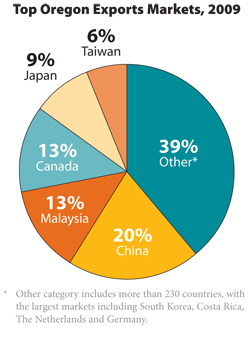 with all exporting and importing activities
in both the manufacturing and nonmanufacturing
sectors. Portland-metro
accounts for 268,000 of those jobs.
with all exporting and importing activities
in both the manufacturing and nonmanufacturing
sectors. Portland-metro
accounts for 268,000 of those jobs.
Recent studies have found that workers in export industries and firms earned substantially more than those in nonexporting industries and firms. One report found that the average wage of workers at exporting firms was 9-18 percent higher than non-exporting firms.
Exports - Merchandise
Oregon and the region are strong centers for the export of goods, including manufactured goods, food, agricultural products and transportation equipment. In 2008, Oregonís merchandise exports exceeded $19 billion before the global recession hit. Prior to the recession, exports of Oregon goods were rising at an average annual rate of more than 16 percent. The manufacturing sector is particularly dependent on international trade, with one in four dollars of sales and a quarter of the sectorís jobs tied to foreign customers.
Exports - Services
Exports of services to international markets make up a significant share of Oregon business sales. Architectural, engineering, computer systems, software, scientific research and telecommunications are increasingly finding markets internationally. In 2002, architectural, engineering and related services registered the largest value of Oregonís service exports to the world, and those exports accounted for over 10 percent of the industriesí total revenue that year.
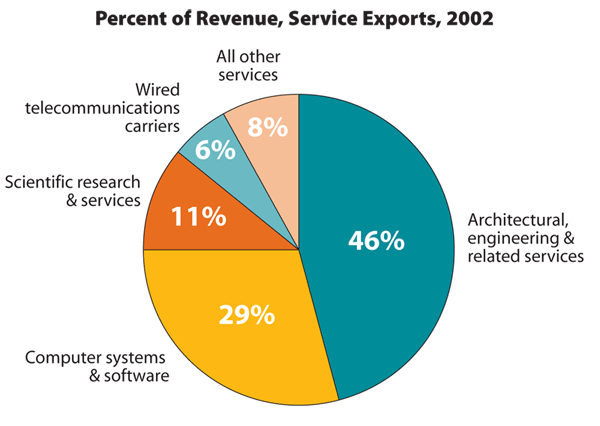
Imports
Contrary to popular belief, most U.S. imports are not finished goods, but raw materials, components and machinery used by U.S. farmers, manufacturers and others to produce goods and services in the United States. Sixty percent of the imports into Oregon in 2008 fall into this category. Imports enable regional manufacturers or service providers and their employees to compete for sales to increasingly costconscious consumers in global as well as national and regional markets.
Foreign investment
Foreign investment in Oregon also contributes to the regionís economy and job base. Majority-owned affiliates of foreign firms employed 44,300 Oregon workers, or about three percent of Oregon workers, in 2007. Twenty-six percent of those jobs were at manufacturing firms owned by subsidiaries of foreign owned firms.
Small Business
Small- and medium-sized firms account for the bulk of Oregonís exporters. In 2008, 88 percent of Oregonís 4,640 exporters were small-or medium-sized firms. That statistic only counts firms tht are direct exporters, it does not include the many related smalland medium-size firms which indirectly exported by selling parts or components that were subsequently incorporated into an export shipment.
Exporting Oregon Values
|
"The growth of Oregon Steel into what itís become simply would not have been possible without the foreign acquisition and investment by Russiaís Evraz Group." Mike Rehwinkel |
Oregonís international firms are carrying the ethic and technology of sustainability across the globe. They export concepts such as sustainability and environmental stewardship with requirements in their purchasing or sales contracts or with tools that their suppliers use to identify sustainable practices. Rejuvenation, a manufacturer of period lighting, is working with its suppliers in China, India and Taiwan to green their supply chain by monitoring waste water and recycling. Glumac, an engineering consulting firm, employs more than 80 LEED accredited professionals to promote environmental practices in countries like India and China. The Oregon electronics industry helped create a program that enables buyers of computers and monitors to measure their environmental impact. Nike recently announced the creation of its Environmental Apparel Design Tool which allows companies to assess the footprint of their products during the design phase.
Athletic & Outdoor Industry
|
"Open trade and markets are critical to the success of Columbia Sportswear. Our highly skilled workforce in the Portland area includes world-class designers, marketers and many other professions." Peter Bragdon |
While manufacturing and distribution of the goods created by Oregon athletic and outdoor companies occurs largely outside the state and country, the research, design, marketing and global management occurs in Oregon. These jobs tend to pay higher wages because they represent the value of the intellectual property associated with a brand. According to the Oregon Employment Department, the average wage in the stateís athletic and outdoor industry in 2009 was $82,700 per year, 79 percent higher than the average wage for all workers. A recent Portland Development Commission report found that 700 firms in this sector employ more than 14,000, with a combined payroll of nearly $1.2 billion. The report estimates that another 3,200 self-employed individuals provide services to the athletic and outdoor sector, generating another $100 million in annual revenue.
DID YOU KNOW?
Oregon receives more patents for footwear than any other state. Portland-metro contains the nationís largest concentration of athletic and outdoor companies. Nike, Columbia Sportswear, Adidas, Danner, Keen, Pendleton and Leatherman are just a few of the companies in this sector that call the Portland-metro region home.

Portland-metro
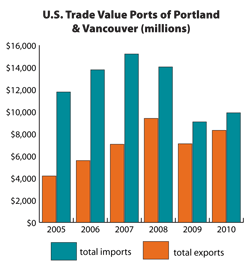 Portland-metro in particular benefits from
international trade and the presence of the
ports of Portland and Vancouver. The
companies and workers at the two ports are
operating around the clock and knit
together into a network of ocean shippers,
transcontinental railways, truck lines, river
barging, and international airports.
Although the recession did not spare
international trade, for the first eight
months of 2010, exports through the ports
were up 17 percent, driven by increases in
raw materials destined for strongly growing
Asian markets. In addition, the ports have
recently seen a 23.4 percent increase in
transportation equipment imports.
Overall, the ports have a significant impact
on the regional economy. Combined the two
ports directly and indirectly supported
more than 34,000 jobs, in 2006.
Portland-metro in particular benefits from
international trade and the presence of the
ports of Portland and Vancouver. The
companies and workers at the two ports are
operating around the clock and knit
together into a network of ocean shippers,
transcontinental railways, truck lines, river
barging, and international airports.
Although the recession did not spare
international trade, for the first eight
months of 2010, exports through the ports
were up 17 percent, driven by increases in
raw materials destined for strongly growing
Asian markets. In addition, the ports have
recently seen a 23.4 percent increase in
transportation equipment imports.
Overall, the ports have a significant impact
on the regional economy. Combined the two
ports directly and indirectly supported
more than 34,000 jobs, in 2006.
|
"As the world has become smaller, ZGF Architects has seen a definite increase in the number of international opportunties, and our company is focusing more on those projects." Nancy Fishman |
Federal Trade Agreements
The ports have also seen a noticeable
increase in traffic, as U.S. free trade
agreements are implemented.
Prior to U.S. extension of Permanent
Normal Trade Relations for China and their
subsequent accession to the World Trade
Organization, Oregon exports to China
amounted to $150 million per year. Since
enactment of Permanent Normal Trade
Relations with China in 2000, Oregon
exports have exploded. In 2009, Oregon
exported $2.9 billion worth of goods to
China; this statistic doesnít measure exports
of services such as engineering and
architecture, so this understates the real
importance of China as a trading partner.
Exports from Oregon to China through June
2010 have nearly doubled compared to 2009,
putting us on pace to export $4.5 billion in
goods to China this year, making China
Oregon's largest export market.*
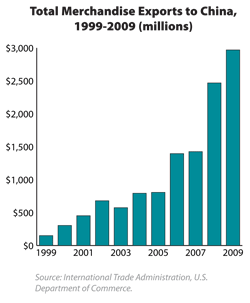 Enactment of bilateral Free Trade
Agreements have also benefited Oregon
exports. The proportion of non-China
merchandise trade with the 17 countries the
U.S. now has Free Trade Agreements with
increased 24 percent between 1996 and
2009. For example, since passage of the
Chile Free Trade Agreement, Oregon's
exports of goods to Chile have increased 50
percent. The U.S. recently entered into a
Free Trade Agreement with Singapore. As a
result, Singapore is on pace to purchase $340
million worth of Oregon goods this year,
making it Oregon's 11th largest export
market.
Enactment of bilateral Free Trade
Agreements have also benefited Oregon
exports. The proportion of non-China
merchandise trade with the 17 countries the
U.S. now has Free Trade Agreements with
increased 24 percent between 1996 and
2009. For example, since passage of the
Chile Free Trade Agreement, Oregon's
exports of goods to Chile have increased 50
percent. The U.S. recently entered into a
Free Trade Agreement with Singapore. As a
result, Singapore is on pace to purchase $340
million worth of Oregon goods this year,
making it Oregon's 11th largest export
market.
* Source: International Trade Administration, U.S.
Department of Commerce








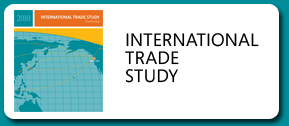
 What the numbers show
What the numbers show